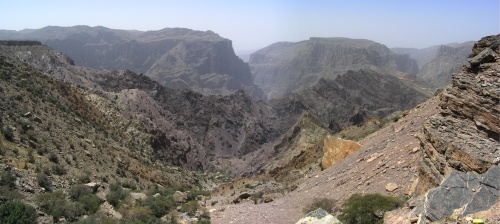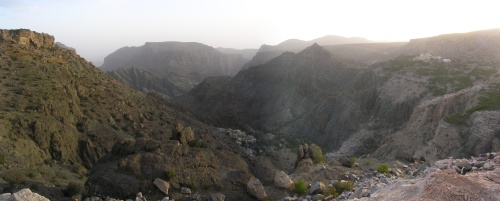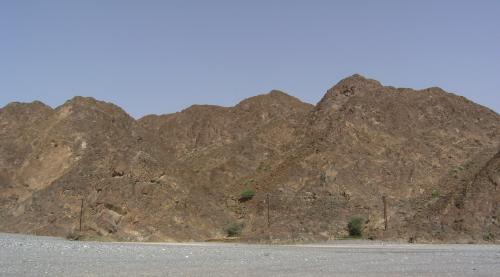Day 6. Today was taken up with a visit to the Ministry of Commerce and Industry, to get clearance for depriving Oman of some of its rocks. This is necessary because Oman is apparently a good place to find meteorites and there’s been some trouble with people exploiting this fact commercially. Getting a clearance letter involved us walking into the ministry and going directly to the office of the Director General of Minerals to ask for one, a somewhat surreal concept for my British sensibilities; I’m fairly sure that if you were trying to do the equivalent thing in the UK, you wouldn’t be able to get in through the front door without an appointment made 3 months in advance. As it was, the clearance letter was procured with a minimum of fuss, with my only source of disquiet being that because it was written in Arabic, I had no idea what it actually said
Day 7. Our next sampling targets were located in the Jebel Akhdar mountains, a couple of hours’ drive to the west of Muscat. The peaks themselves are made up of much younger Mesozoic carbonates, with the older Neoproterozoic sequences we were interested found only in the core of the range, where upwarping combined with erosion had exposed them. Thus we were treated to some rather spectacular views as we drove over and into the wadis in the farthest interior.

Our sampling today involved 650 million year old volcanic rocks, most commonly in the form of pillow basalts:

and one of the archetypal ‘Snowball Earth’ sequences, where a diamictite (a kitchen sink type of rock that contains everything from mud particles right up to boulders, all jumbled together) that is argued to be deposited by glaciers is directly overlain by a carbonate that appears to have been chemically precipitated in warm water.

The extreme climatic upheaval suggested by this quick change from very cold conditions to a near tropical environment, and the fact that similar sequences of similar age are found all over the world, indicate that strange things were afoot in the Neoproterozoic world (more on this in a later post).
As we finished off our sampling in the waning light, the call to prayer wafting over the landscape provided an otherworldly ambience to the spectacular scenery.

Day 8: Another day in the Jebel Akhdar, although in an entirely different wadi. To get to this one, we had to drive through the ophiolite – these hills are actually made of oceanic mantle rocks, which are normally only found – in a much less weathered form – 10 km below the sea floor.

Following that we drove into the mountains through a dried riverbed at the base of a spectacular gorge; one look at what the occasional flood had wrought topographically, and the size of the boulders that had been scattered all around by such floods, was enough to make you hope to be a long way away when the rains come.

Our target today was another section through the diamictite/carbonate couplet.

The diamictite is the furthest to the right in this sequence, with the carbonate on the left. Sampling the same sequence in different places – particularly if it has been tilted into a different orientation – is an important part of validating palaeomagnetic data.
Day 9. This was our last day in the Jebel Akhdar region, which we spent sampling fine-grained sandstones a little higher stratigraphically, and therefore younger, than the carbonate we had drilled the day before.

This was another duplication; this was the same formation that we sampled on our first day in central Oman. As it was there, drilling was difficult, but with some perseverance we managed to collect a lot of cores, albeit often somewhat fractured ones. Possibly the heat was getting to me, because at this point it seemed like a wonderful idea to pose next to an Omani flag painted on the canyon wall.

Definitely time to return to base, even if no beer was available.



Comments (7)